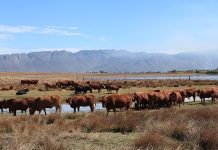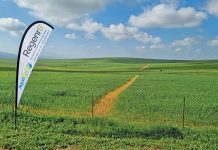Some animal diseases are easily spread from game to domestic herds. The pathogens are constantly adapting and, without careful management, can have a serious impact on both the wildlife and livestock industries. Roelof Bezuidenhout reports.
Because of changing disease patterns and the continually changing effects of diseases on wildlife, livestock and humans, the management of disease in wildlife should focus not only on the health of all animals but also on the state of the ecosystem they live in. That is according to Prof Nick Kriek of the Centre for Veterinary Wildlife Studies in the Faculty of Veterinary Science, University of Pretoria. Kriek warns that the risk of a disease developing and establishing itself in specific areas is affected by several factors, including changes in the disease organism in terms of pathogenicity and target species, the changing nature of borders and the changing epidemiology of diseases. “Changes in natural phenomena such as global warming, deforestation and bush encroachment seem to be becoming more important. Also, changes in land- use patterns, informal small-scale farming and the level of competency of regulatory authorities further complicate the occurrence and successful control of animal diseases,” says Kriek.
Pointing out that outbreaks of diseases in wildlife are frequently related to an over-abundance of key species and to climate change, Kriek says it is usually impossible to predict whether a disease will become significant. “Even the consequences of these infections are unpredictable and poorly understood, but they can affect wildlife at population level and in its environment. Small populations can even be driven to extinction. Corridors linking small isolated populations increase both the risk associated with the movement of reservoir hosts and the frequency of exposure.’’
Exercise extreme caution
For these reasons, says Kriek, when ranchers introduce animals onto land they should know there are no guarantees. “With some diseases one can simply take no risk at all, so do not rely on assumptions. Make sure you know the disease status of the animals and the validity of certificates stating that disease. Know the interval between test and sale, and how valid the tests and the interpretation of the test results are,” he suggests. While wildlife diseases are of little importance in the day-to-day management of ranches and conservancies, they can cause huge headaches when they do occur. Animal disease is often an emotional issue, particularly at the interface between livestock and wildlife ranching and conservation. Kriek believes critical issues that must be managed include the two-way transmission of disease between wildlife and domesticated animals, the implications of diseases transmitted from animals to humans (zoonotic diseases), and the consequences of wildlife diseases for the wildlife and livestock industries. International standards for local and international trade in animals and animal products can increase financial losses. Serious economic diseases – often called transboundary animal diseases or TADs – carried and/or sustained by wildlife – should be of prime concern when farming with livestock and wildlife. Examples are foot-and-mouth disease, tuberculosis, lung sickness, Rift Valley fever and theileriosis (corridor disease and East Coast fever). TAD outbreaks require increased international efforts to contain them and have an adverse impact on the macroeconomy, local socio-economic stability and food security at local, national and regional level.
In addition they lead to increased exposure to zoonotic diseases, and have a negative impact on biodiversity, peoples’ livelihoods and the development of health and welfare. Kriek recommends that disease management strategies should be proactive rather than reactive. “Know what is happening on your ranch or conservancy. Management strategies should include passive surveillance of the level of parasitic infection and the presence of specific diseases, population density management, biological control of disease agents and vectors, adequate diagnostics, and husbandry and management practices,’’ he advises. Contact Prof Kriek at [email protected]. |fw
A breakdown of possible outbreaks
Animal diseases can be categorised as indigenous, exotic (introduced), or emerging or re-emerging. More practically, they may be classified as Afro-endemic, alien or emerging/re-emerging, or multi-species infections, according to Prof Kriek.
Afro-endemic infections are native to the African continent and are frequently maintained by one or more wildlife hosts. These diseases are normally subclinical in their natural hosts, but highly pathogenic and often fatal in livestock. Some of the more important examples are foot-and-mouth disease and corridor disease (maintained by African buffalo), bovine malignant catarrhal fever in wildebeest, African swine fever in wild pigs, and, probably, African horse sickness and equine encephalosis in zebra. Alien (exotic) or emergent infections can impact significantly on wildlife populations that are fully susceptible to the new pathogens.
Rinderpest is perhaps the best example. It affected wildlife and livestock at the end of the 19th century to such an extent that the biodiversity of the eastern and southern African regions took more that 60 years to recover. Another disease, bovine tuberculosis, has over time infected wildlife in certain areas of the country so badly that the infection has become established in those populations, making it very expensive and difficult, if not impossible, to eradicate.
Bovine tuberculosis is an insidious disease that can be contracted by a wide range of mammals, including humans. It has been present in cattle in South Africa for the last 250 years, after its introduction from Europe. The disease was first diagnosed in kudu in the Eastern Cape in the 1930s. Thereafter it was found in buffalo, first in the Hluhluwe Game Reserve in the 1970s, and then in the Kruger National Park (KNP) in the early 1990s. In the KNP and surrounding areas the disease has now spread to at least 12 other species, including lion. The impact on these cats appears to be particularly severe on their pride structure, longevity and social dynamics.
Multi-species infections are quite common. They include anthrax and rabies that are both endemic in South Africa and affect domesticated animals, wildlife and humans. The dynamics of the disease and the species affected in different habitats and ecosystems vary substantially. For example, anthrax in the Zimbabwean and South African eastern lowveld savannah affects spiral-horned antelope, buffalo, waterbuck and roan antelope. However, in the Namibian and Botswana arid savannah, elephant, zebra, wildebeest and springbok are affected. “It is thus risky to simply extrapolate from what happens in one area when assessing the impact of disease in other parts of the country,” warns Kriek.








